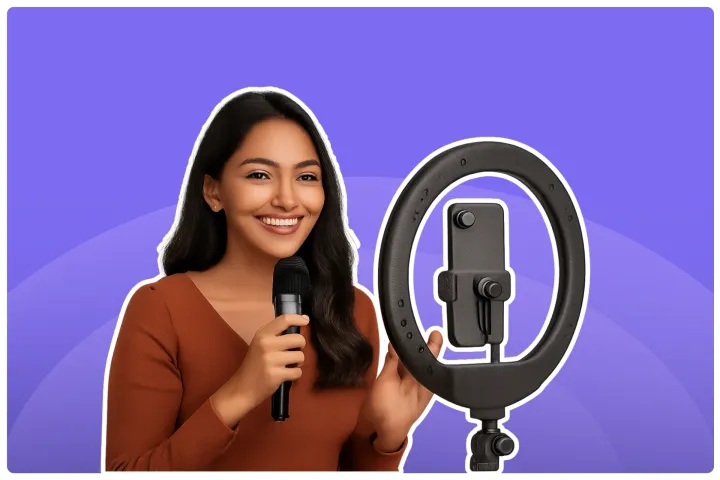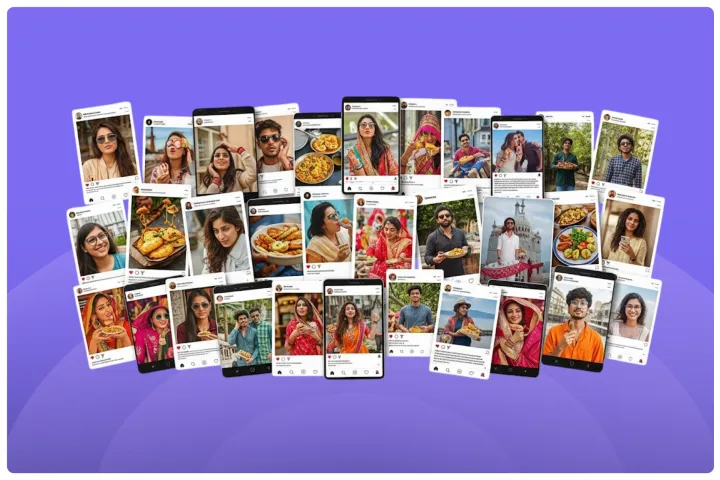Importance Of User Generated Content: Why & How (2025)
User-generated content can elevate your brand! Learn why it matters and how to encourage your audience to share their experiences with you.
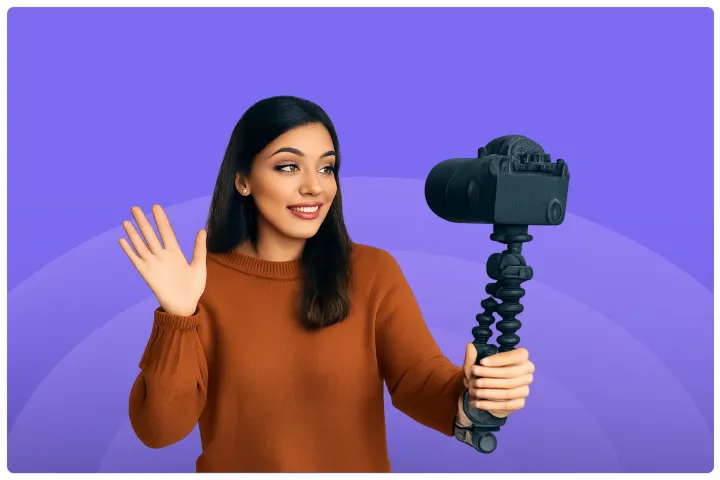
In today's world, your customers are not just passive receivers of your marketing messages. They are active participants, creators, and storytellers. They are already talking about your brand, sharing their experiences, and creating content. The question is, are you tapping into this goldmine?
This guide is your friendly manual to understanding what UGC is, why it's a superhero for your brand, and how you can use it effectively. We'll also touch upon a cool platform called ryme.ai that can make your journey with UGC and influencer collaborations smooth sailing. So, grab a cup of chai ☕, get comfy, and let’s dive into making your brand the talk of the town – in the best way possible!
What Is User-Generated Content?
Alright, let's break it down. User-Generated Content (UGC) is pretty much what it sounds like: any form of content created by people, rather than brands. These are your everyday users, your loyal customers, or even just folks who’ve had an experience with your product or service. They create and share this content voluntarily, often on their social media channels, websites, or forums.
Imagine your customer, Riya, buys a beautiful handcrafted saree from your online store. She loves it so much that she posts a picture wearing it on her Instagram, tagging your brand and sharing how elegant it made her feel. That photo, her caption, her genuine appreciation – that's UGC! It’s not an ad you paid a model for; it’s a real person showcasing their real experience.
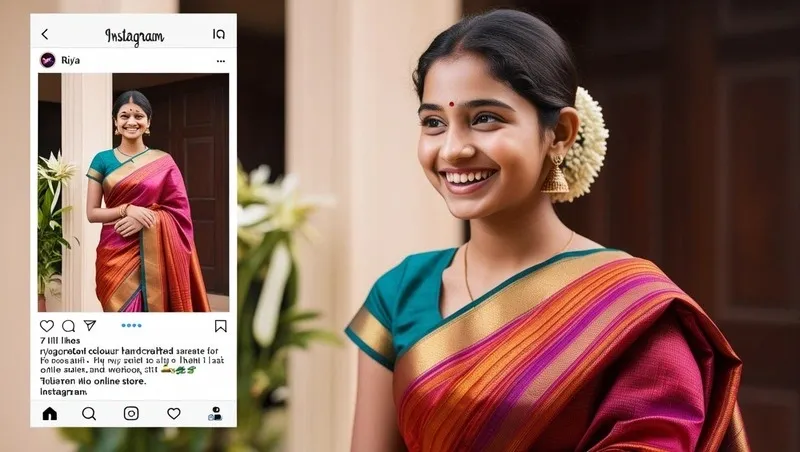
UGC is the digital equivalent of word-of-mouth marketing, but with a much wider reach thanks to the internet and social media. It’s authentic because it comes from a place of genuine experience, not from a marketing brief. This authenticity is what makes it so believable and trustworthy to other potential customers. Think of it as your customers becoming your most enthusiastic (and often most effective) brand ambassadors, without even being on your payroll! It’s about real people sharing real stories, and that’s something no amount of marketing budget can truly replicate.
Types of UGC:
User-Generated Content comes in all shapes and sizes. It's as diverse as your customer base! Understanding the different types can help you spot opportunities and encourage more of it. Let's look at some of the most common and impactful forms:
Social media posts (e.g., Instagram photos, TikTok videos, Tweets):
This is probably the most visible type of UGC. Think about:
Instagram: Customers posting photos wearing your apparel, using your product in their daily life, or creating artistic shots featuring your packaging. For example, a fitness enthusiast might post a Reel of their workout using your brand's protein powder, tagging you. Imagine a carousel post by a travel blogger showcasing their stay at your boutique hotel, complete with stunning visuals and a heartfelt caption.
TikTok: Short, catchy videos are king here. Users might create funny skits involving your product, participate in a branded hashtag challenge you initiated, or film a quick "day in the life" that subtly features your item. A beauty brand could see users creating makeup tutorials using their latest eyeshadow palette.
Twitter (now X): Customers might tweet about their positive experience with your customer service, share a quick thought on your new product launch, or participate in a trending conversation related to your industry, mentioning your brand.
Facebook: Users might post recommendations on their timeline, share your brand's content with their own commentary, or check into your physical store, sometimes with a photo.
Customer reviews and testimonials:
These are gold! They are direct endorsements (or critiques, which are also valuable for feedback) from people who have spent their hard-earned money on your product or service.
On your website: Displaying reviews directly on your product pages can significantly influence purchase decisions. For instance, an e-commerce site selling electronics would benefit immensely from detailed reviews highlighting product performance and durability.
Third-party review sites: Platforms like Google Reviews, Amazon, Zomato, TripAdvisor, G2, Capterra, etc., are go-to places for people looking for unbiased opinions. A high rating on Zomato can drive significant footfall to a restaurant.
Video testimonials: A customer sharing their success story on video can be incredibly persuasive. Imagine a student talking about how your online course helped them land their dream job. It’s powerful!
Unboxing and product demonstration videos:
These are super popular, especially on YouTube and Instagram.
Unboxing videos: There's a certain excitement in watching someone open a package for the first time. It shows off your product and packaging in a real-world setting. A lifestyle influencer might unbox a subscription box from your brand, showing each item with genuine reactions.
Product demonstration/Tutorial videos: Users showing how to use your product, its features, or different ways it can be utilized. For example, a tech enthusiast might create a detailed video explaining the setup and features of your new smart home device. Or a DIY enthusiast showing how they used your craft supplies to create something amazing.
Blog posts and forum discussions:
While it might seem a bit old-school to some, long-form content and community discussions still hold immense value.
Blog posts: A customer might write a detailed review of your software on their personal blog, or a travel blogger might dedicate an entire post to their experience with your tour package. These often provide in-depth insights.
Forum discussions: Platforms like Reddit, Quora, or niche industry forums often have users discussing products, asking for recommendations, or sharing solutions. Your brand or product might be mentioned organically in these conversations. For example, someone on a parenting forum might recommend your baby care product to a new mother.
Each of these types of UGC offers a unique way for your audience to engage with and advocate for your brand. The key is to recognize them and understand their potential.
Platforms Where UGC Thrives:
UGC can pop up anywhere online, but some platforms are particularly fertile ground for it. Knowing where your audience is creating and sharing content helps you find it and encourage more of it.
Instagram, TikTok, YouTube: These are the visual powerhouses.
Instagram: Perfect for aesthetically pleasing photos and short videos (Reels, Stories). Its visual nature makes it ideal for products in fashion, beauty, food, travel, and lifestyle. Hashtags are crucial here for discoverability. Many brands find success by encouraging users to post with a specific branded hashtag (e.g., #MyBrandStyle).
TikTok: This platform is all about short, engaging, and often entertaining video content. It's fantastic for trends, challenges, and creative expressions. Brands that can tap into TikTok's unique culture, perhaps by launching a fun dance challenge related to their product, can see explosive UGC growth. Given its young demographic, it's a great place to connect with Gen Z.
YouTube: The home of long-form video content. Ideal for detailed reviews, in-depth tutorials, unboxing experiences that last more than a minute, and vlogs where your product might feature. A tech gadget brand would find a lot of value in YouTube reviews.
Brand websites and e-commerce platforms:
Your own digital properties are prime real estate for showcasing UGC.
Dedicated UGC galleries: Many brands now create sections on their website to feature customer photos and videos. This not only provides social proof but also makes your website more dynamic and engaging. Imagine an apparel brand with a "Shop The Look" gallery populated by customer photos.
Product pages: Integrating customer reviews and ratings directly onto product pages is almost a necessity now. According to a 2023 study by PowerReviews, over 99.9% of consumers consult reviews when shopping online. Seeing photos from other buyers using the product can also significantly boost conversion rates.
Community forums: Some brands host their own forums where users can discuss products, share tips, and help each other. This fosters a sense of community and can be a rich source of UGC and feedback.
Online communities and forums (like Reddit, Quora, niche forums):
While not directly controlled by you, these platforms are where honest conversations happen.
Reddit: Has countless communities ("subreddits") dedicated to specific interests, hobbies, and even types of products. Users often ask for recommendations or share their experiences here. For example, in a subreddit like r/SkincareAddiction, users frequently post routines and product reviews.
Quora: A Q&A platform where people seek advice and information. Your product might be mentioned as a solution to a user's problem.
Niche Forums: Dedicated forums for specific industries (e.g., photography forums, automotive forums, parenting forums) are treasure troves of detailed UGC and expert opinions. If your product caters to a specific hobby or profession, these forums are important to monitor.
By understanding where your target audience hangs out and shares content, you can actively listen, engage, and encourage the creation of UGC that benefits your brand. It’s about meeting your customers where they are.
Importance of User Generated Content
So, we know what UGC is and where to find it. But why should you, as a brand, really care? Why go through the effort of encouraging, collecting, and showcasing it? Oh, let me tell you, the reasons are plenty and powerful! UGC isn't just a "nice-to-have"; it's rapidly becoming a cornerstone of successful marketing strategies. Let's explore why it's so crucial for your brand's health and growth.
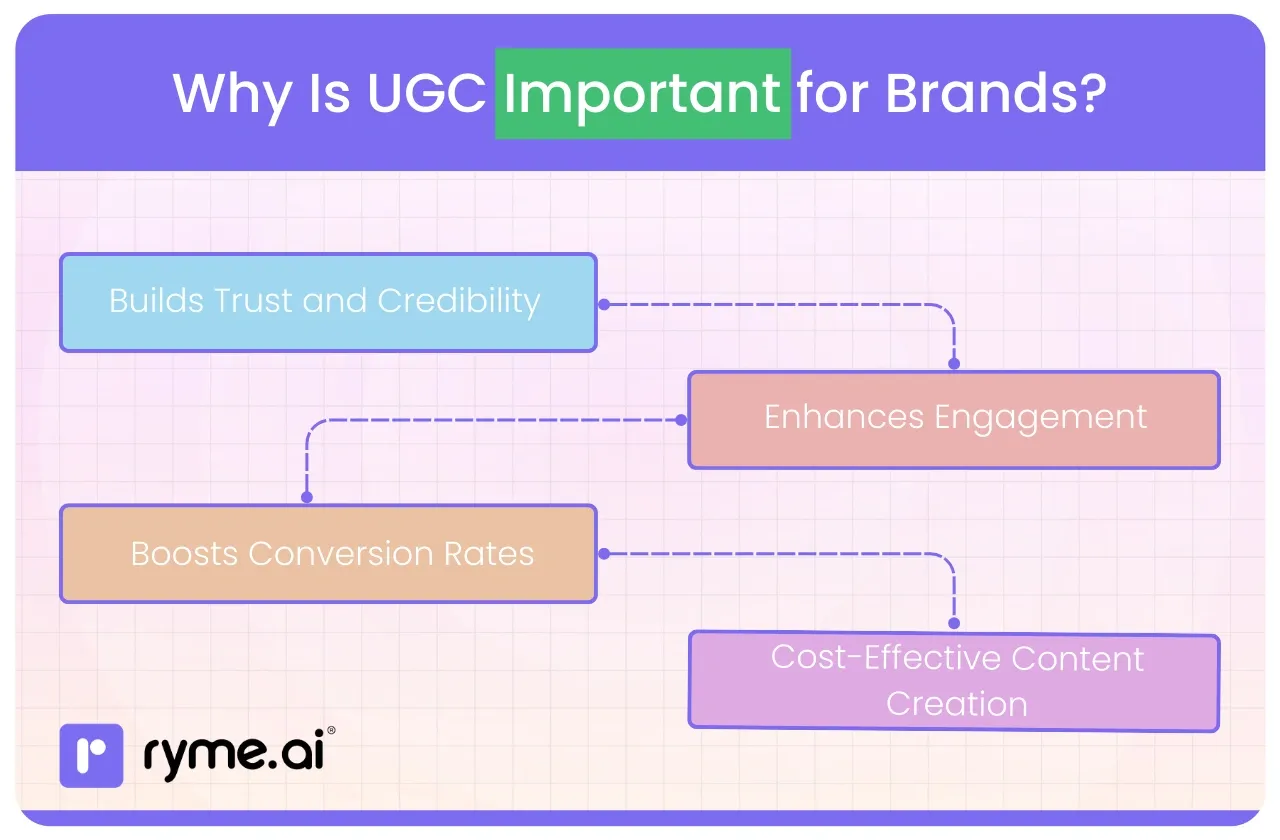
1) Builds Trust and Credibility:
This is perhaps the BIGGEST benefit of UGC. In a world saturated with advertisements, consumers have become increasingly skeptical of traditional brand messages. We’re constantly bombarded with polished, perfect images and carefully crafted taglines. UGC cuts through this noise like a hot knife through butter.
Consumers trust peer recommendations over brand messages:
Think about your own purchasing decisions. Are you more likely to trust an ad that claims a product is "the best," or a review from someone who has actually used it and shares their honest, unfiltered opinion? Nielsen’s Global Trust in Advertising report has consistently shown that recommendations from people I know (friends, family) are the most trusted form of advertising. Following closely are online consumer opinions.
A recent study by Stackla (though a bit before our 2022 cutoff, the trend holds and has intensified) found that 79% of people say UGC highly impacts their purchasing decisions, compared to just 13% for brand-produced content and 8% for influencer content. While specific numbers vary by study and year, the overwhelming sentiment remains: authenticity sells, and UGC is authenticity personified. In 2023, a BrightLocal survey found that 88% of consumers trust online reviews written by other consumers as much as they trust recommendations from personal contacts. This is huge!
When potential customers see real people – not paid actors or models – using and loving your product, it feels genuine. It’s like getting a recommendation from a trusted friend. This perceived authenticity builds a strong foundation of trust.
UGC serves as authentic social proof:
Social proof is the psychological phenomenon where people assume the actions of others reflect correct behavior for a given situation. When prospects see that others are buying, using, and enjoying your products, it validates their own decision-making process. It tells them, "Hey, other people like me are choosing this brand, so it must be good!"
Imagine a potential customer is hesitating to buy a new software for their business. They see a testimonial video on your website from another small business owner, just like them, explaining how your software helped them save time and increase efficiency.
That’s powerful social proof in action! Or consider an online clothing store. Seeing photos of other customers of various body types wearing an outfit can give a shopper much more confidence to purchase than seeing it only on a professional model. It answers the silent question: "Will this look good on me?"
For example, let's say you sell eco-friendly home cleaning products. A customer posts an Instagram Story showing how effectively your all-purpose cleaner tackled a tough stain, adding text like "Amazed by @YourBrand’s cleaner! 🌿 #EcoClean #SafeForPets". This isn't just a post; it's a mini-testimonial broadcast to their network, building your brand's credibility one share at a time.
2) Enhances Engagement:
UGC is not a one-way street. It's a conversation starter. It invites interaction and builds a sense of community around your brand. When customers feel like they are part of your brand's story, their loyalty and engagement skyrocket.
Encourages community interaction and participation:
When you feature UGC, you're acknowledging and celebrating your customers. This makes them feel valued and seen. It encourages others to participate, hoping to get featured too. This creates a vibrant community around your brand. Think about running a contest where you ask users to share their creative ways of using your product. The entries pour in, people comment on each other's posts, and a sense of camaraderie builds up.
For instance, a coffee brand could ask customers to share their #MyMorningRitual photos featuring their coffee. This not only generates content but also allows customers to connect over shared experiences. Replying to these UGC posts, thanking users, and asking follow-up questions further boosts engagement. "That looks like a perfect start to the day, Priya! What's your favorite blend?"
Increases brand visibility through shared content:
Every time a user posts about your brand, they are exposing it to their own network of followers. This organic reach can often be far more effective (and cheaper!) than paid advertising. If Riya posts about your saree to her 2,000 followers, and even a small percentage of them engage with it or check out your brand, that's a significant visibility boost. If her post is particularly engaging, her followers might share it too, creating a ripple effect.
This is especially true for visually appealing products or services. A travel company that encourages tourists to share photos from their trips using a specific hashtag can quickly gain visibility among travel enthusiasts. Each post acts like a mini-advertisement, endorsed by a trusted source. A 2022 study by Sprout Social indicated that 70% of consumers feel more connected to brands whose CEO is active on social media; imagine the connection they feel when the brand actively engages with their content!
3) Boosts Conversion Rates:
Ultimately, as a brand, you're interested in how these efforts translate into sales. And the good news is, UGC has a direct and positive impact on conversion rates. More trust and engagement naturally lead to more sales.
UGC can lead to higher click-through and conversion rates:
When UGC is incorporated into your marketing funnel, especially on product pages or in ads, it can significantly increase the likelihood of a purchase. Seeing real people happily using a product reduces perceived risk and builds purchase confidence.
A report by Bazaarvoice in 2023 highlighted that even a single user-generated photo next to a product can increase its conversion rate. Specifically, they found that when shoppers engage with UGC, there's a 102.4% lift in conversion rate. Websites that transitioned from no UGC to incorporating it saw an average revenue per visitor increase of 90.6%.
Imagine you run an e-commerce store selling custom phone cases. On your product page for a specific design, alongside the professional product shots, you include an Instagram feed showcasing customers’ photos with that exact phone case. This visual proof from peers can be the final nudge a hesitant buyer needs.
Brands have seen significant increases in sales by incorporating UGC:
Many brands have reported remarkable success after strategically integrating UGC. For example, a popular cosmetics brand might run a campaign asking users to share their makeup looks using a new product. They then feature these images on the product's sales page. Seeing the product on different skin tones and face shapes, applied in various creative ways by real users, makes it more appealing and relatable, driving up sales.
Let's say "ChaiWalla," a local tea cafe chain, starts a campaign #MyChaiWallaStory, encouraging customers to share their favorite moments at the cafe. They feature the best stories on their social media and in-store displays. This creates a buzz, brings in more foot traffic from people who want to experience these moments, and ultimately boosts sales of their teas and snacks. They might see a 15-20% increase in repeat customers and a 10% rise in new customer acquisition within a few months of actively promoting and featuring UGC.
4) Cost-Effective Content Creation:
Creating high-quality content consistently can be a major expense for brands. Professional photoshoots, video production, and graphic design all add up. UGC offers a brilliant, budget-friendly alternative.
Reduces the need for expensive professional content production:
Instead of constantly needing to spend thousands or even lakhs of rupees on new marketing visuals, you have a steady stream of authentic content coming directly from your users. While professional content still has its place for core branding, UGC can fill your content calendar, especially for social media, with fresh and diverse visuals.
Think about the cost of a single day's professional photoshoot for a fashion brand – studio rental, photographer, models, stylists, post-production – it could easily run into ₹50,000 to ₹2,00,000 or more. Now compare that to curating 10-15 high-quality customer photos shared organically or through a simple contest with a modest prize. The cost savings are undeniable.
Leverages existing content created by consumers:
Your customers are already creating this content! You just need to find it, get permission, and use it strategically. This means you're tapping into a resource that's already there, waiting to be utilized. It's like discovering an untapped oil well in your backyard.
For example, a software company could collect positive tweets and LinkedIn posts from users praising their customer support or a new feature. These can be used as testimonials on their website or in presentations, at virtually no cost beyond the time taken to gather and curate them.
In essence, UGC helps you build a more trustworthy brand, foster a more engaged community, convert more prospects into customers, and do it all without breaking the bank. It’s about working smarter, not just harder, by empowering your happiest customers to become your most vocal advocates. Pretty neat, huh? 😉
How to Leverage UGC Effectively
Okay, so you're convinced. UGC is awesome. But how do you actually get your hands on it and use it effectively? It’s not just about passively waiting for content to appear. You need a strategy. Here’s how you can actively encourage, curate, and utilize UGC to its full potential, making your customers feel like superstars and your brand shine. ✨
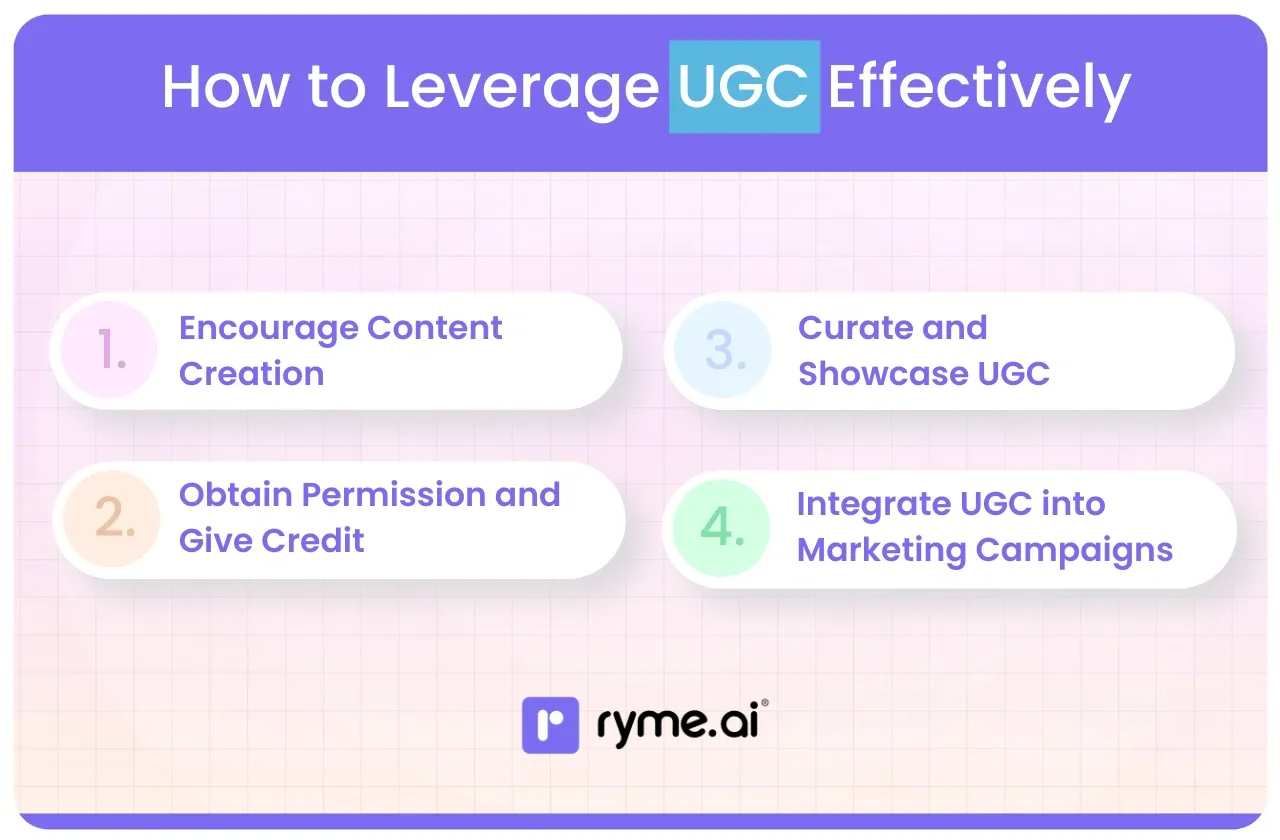
1) Encourage Content Creation:
Your customers might already love you, but sometimes they need a little nudge or inspiration to create and share content. Here’s how you can get the ball rolling:
Run contests or challenges that motivate users to create content:
Contests are a fantastic way to generate a buzz and a flood of UGC in a short period. The key is to make them fun, easy to participate in, and relevant to your brand.
- Photo/Video Contests: Ask users to submit photos or videos featuring your product in a creative way. For example, a travel gear company could run a "Best Adventure Shot with Our Backpack" contest. Imagine an Instagram post: "WIN a ₹10,000 travel voucher! 🎒 Show us your most epic adventure with your [Your Brand] backpack! Post your photo/reel, tag us @YourBrand, and use #YourBrandAdventure. Contest ends [Date]. T&Cs apply."
- Hashtag Challenges: Create a unique and memorable hashtag and encourage users to create content around a specific theme. TikTok is famous for these. A snack brand could launch a #MySnackCreation challenge, asking users to share unique recipes using their product.
- Caption Contests: Post an interesting image related to your brand and ask users to come up with the best caption.
- "Story of the Week/Month": Encourage users to share their experiences with your product/service, and feature the best one regularly. This provides ongoing motivation.
Offer incentives like discounts or features on your brand's channels:
People love recognition and rewards! Incentives don't always have to be big-ticket items.
- Discounts & Coupons: Offer a discount on their next purchase for sharing a photo with your product or writing a review. "Share a pic with your new [Your Product] & tag us to get 15% off your next order!"
- Feature on Your Channels: The chance to be featured on your brand’s official Instagram page, website, or newsletter can be a huge motivator, especially for users looking to grow their own social media presence. A simple "Tag us @YourBrand in your photos for a chance to be featured!" in your bio can work wonders.
- Freebies or Swag: Send out exclusive brand merchandise or new products to users who create exceptional content.
- Early Access: Offer loyal customers who create UGC early access to new products or features.
- Points & Loyalty Programs: Integrate UGC creation into your loyalty program. For example, award points for reviews or social shares.
- Pro-Tip: Make it super clear what you want users to do. Provide specific calls-to-action (CTAs). For example, instead of just saying "Share your photos," try "Share a photo of your favorite way to use our [product name] with #OurBrandLove for a chance to win a ₹5,000 gift card!"
2) Curate and Showcase UGC:
Once the content starts flowing in, you need a system to collect, filter, and showcase the best pieces. This is where you turn individual posts into a powerful collective voice for your brand.
Create galleries or hashtags to display user content on your website and social media:
- Website Galleries: Dedicate a section on your homepage or product pages to a live feed of UGC. This can be a "Shop Our Instagram" type of gallery where users can see products in real-life settings and click through to purchase. Tools like Taggbox, SocialVip, or even custom integrations can help you create these. Imagine a fashion brand's website with a "Styled by You" section displaying a beautiful mosaic of customer photos, each linking to the featured product.
- Branded Hashtags: This is your primary tool for collecting UGC on platforms like Instagram and Twitter. Choose a unique, easy-to-remember hashtag (e.g., #YourBrandStyle, #My[YourBrand]Moment). Regularly monitor this hashtag to find content.
- Social Media Features: Regularly repost or share user content on your own social media profiles (with permission, of course!). Instagram Stories are great for quick features, while feed posts can highlight exceptional content. You could do a "Fan Photo Friday" or a weekly UGC roundup.
Highlight customer stories and testimonials to humanize your brand:
Go beyond just photos. Share the stories behind the content.
- Written Testimonials: Feature detailed testimonials on your website, perhaps with a photo of the customer. These add credibility and depth.
- Video Testimonials: If a customer creates a great video review, ask if you can share it. Or, proactively reach out to happy customers and ask if they’d be willing to record a short video. These are incredibly engaging.
- Case Studies (B2B): For B2B brands, detailed case studies showing how a client achieved results using your product or service are a powerful form of UGC.
- "Customer Spotlight" Series: Dedicate blog posts or social media series to highlighting individual customers, their journey, and how your brand played a part. This makes your customers feel truly special and shows prospects how your brand can impact real lives. For example, Riya, who gained 10k followers in 3 months by consistently creating high-quality travel content featuring various travel gear brands (including yours!), could be a great spotlight. Her story isn't just about your product, but about her success, which your product supported.
- Remember: Curation is key. Not all UGC will be high quality or perfectly aligned with your brand image. Choose content that is authentic, visually appealing (if applicable), and reinforces your brand values.
3) Obtain Permission and Give Credit:
This is super, super important! Using someone's content without their permission is a big no-no. It can lead to legal trouble and damage your brand's reputation. Always prioritize respect and transparency.
Always ask for permission before using user content:
Just because someone tagged your brand or used your hashtag doesn't automatically give you the right to use their content for your own marketing purposes (e.g., on your website, in ads, or even reposting on your main feed sometimes, depending on the platform's norms and your intended use).
- How to ask: The best way is to send a direct message (DM) or leave a comment on their post. Keep it friendly and clear.
- Template for asking permission: "Hi [User Name]! We absolutely love this photo/video of [your product/their experience]! 😍 Would you mind if we shared it on our [platform, e.g., Instagram feed, website gallery]? We'll be sure to credit you, of course! Please reply with #Yes[YourBrand] if you agree. Thanks!"
- Rights Management Tools: For larger brands dealing with a high volume of UGC, there are tools (some UGC platforms offer this) that can help automate the permission-seeking process and keep track of rights.
Credit the original creators to build goodwill and trust:
This is non-negotiable. Whenever you use UGC, clearly credit the original creator, usually by tagging their social media handle and mentioning their name.
- Why it matters: It shows respect for their work, gives them exposure (which they'll appreciate!), and reinforces your brand's authenticity. It also encourages others to share content, knowing they'll be acknowledged.
- How to credit: On Instagram, tag them in the photo/video and mention them in the caption (e.g., "Amazing shot by @[UserHandle]! 📸"). On your website, include their name or social media handle near the image.
By being diligent about permissions and crediting, you foster a positive relationship with your content creators and maintain ethical marketing practices.
4) Integrate UGC into Marketing Campaigns:
Don't just let UGC sit in a gallery. Actively weave it into your broader marketing efforts to amplify its impact.
Use UGC in email marketing, advertisements, and product pages:
- Email Marketing: Include a customer photo or a glowing testimonial in your newsletters. This can make your emails more visually appealing and persuasive. "See how Rina styled our latest Kurti! 💖 [Customer Photo]"
- Advertisements: UGC can make your paid ads feel more organic and trustworthy. Test using customer photos or videos in your Facebook, Instagram, or Google ads. According to a 2023 Meta report, ads featuring UGC saw a 300% higher click-through rate (CTR) compared to traditional ads for some campaigns. This is because they look more like native content in users' feeds.
- Product Pages: As mentioned earlier, embedding reviews and customer photos directly on product pages can significantly increase conversion rates. It provides social proof right at the point of decision.
Incorporate user content into influencer collaborations for added authenticity:
When you're working with influencers, encourage them to solicit UGC from their followers as part of the campaign. For example, an influencer could run a contest for your brand, asking their audience to participate by creating their own content.
You can also have influencers react to or engage with existing UGC related to your brand, further validating those user experiences. This blends the reach of influencers with the raw authenticity of everyday users, creating a powerful combination.
By strategically leveraging UGC, you're not just collecting content; you're building a community, fostering trust, and driving real business results. It's about making your customers the heroes of your brand story.
User Generated Content: Challenges and Considerations
While UGC is a fantastic asset, it’s not always smooth sailing. Like any powerful tool, it comes with its own set of challenges and things you need to keep in mind. Being aware of these potential hurdles will help you navigate them effectively and make your UGC strategy even stronger. Let's be real about what you might encounter.
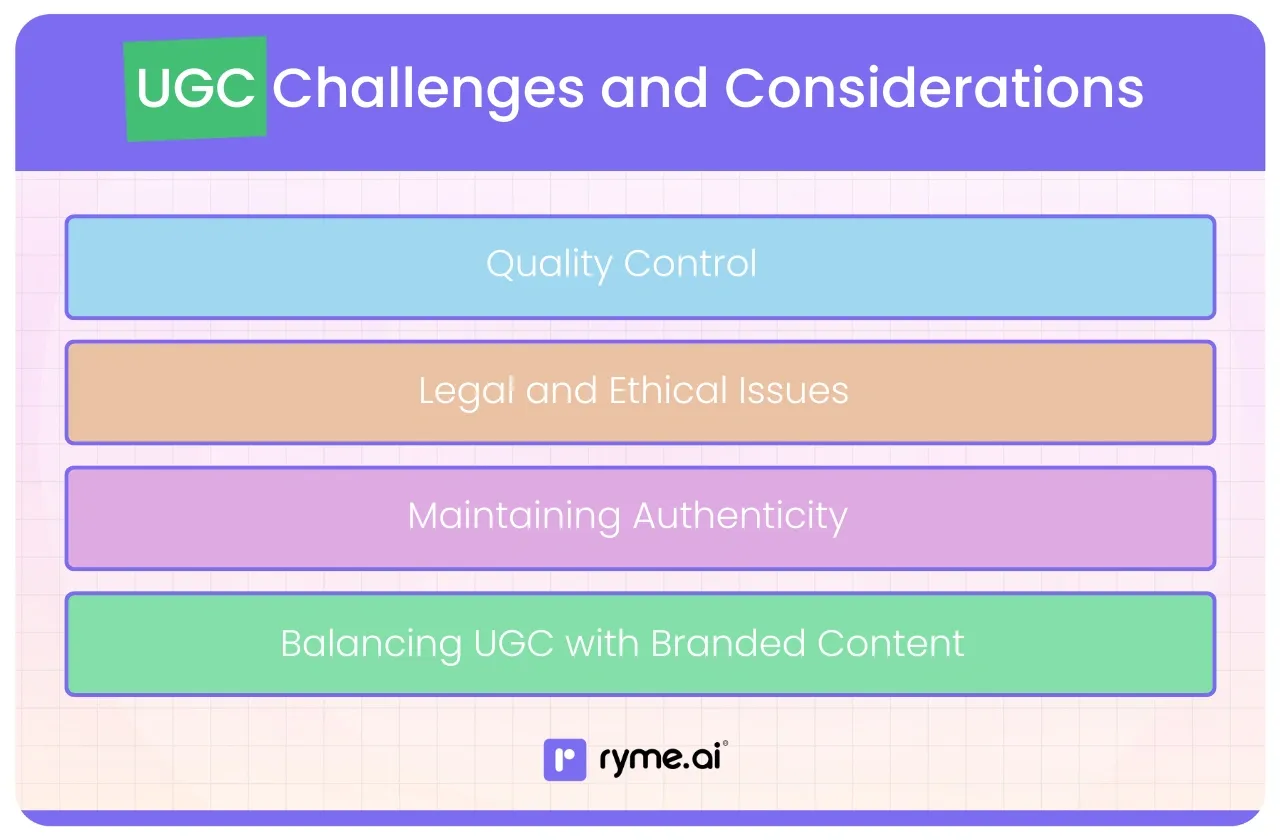
1) Quality Control:
Not all UGC is created equal. You'll get a mix of amazing, high-quality content and some... well, not-so-great stuff. Ensuring the content you showcase aligns with your brand's image and standards is crucial.
Ensuring the content aligns with brand values and standards:
The photo might be blurry, the lighting poor, or the context not quite right for your brand. Sometimes, the content might even inadvertently go against your brand values (e.g., showing unsafe use of a product).
What to do:
Set Clear Guidelines (Gently): When running contests or specific UGC campaigns, provide simple guidelines or inspiration. For example, "We love bright, clear photos!" or "Show us how our product brings joy to your day." But be careful not to be too restrictive, as that can stifle creativity.
Moderation is Key: You need a process to review all tagged content or submissions before featuring them. This doesn't mean rejecting everything that isn't professional-grade, but it does mean filtering out content that is offensive, irrelevant, extremely low quality, or doesn't reflect your brand positively.
Focus on Authenticity over Perfection: Remember, the charm of UGC lies in its realness. A slightly imperfect but genuine photo can often be more effective than a staged one. Don't aim for a super-polished look for all your featured UGC.
Tools: Some UGC platforms offer moderation dashboards that allow you to approve or reject content, making the process easier, especially at scale.
It's a balancing act. You want to maintain a certain level of quality and brand consistency, but you also want to embrace the raw, authentic nature of UGC.
2) Legal and Ethical Issues:
This is a big one. When you're using content created by others, you step into the territory of intellectual property, rights, and privacy. Ignoring these can land you in hot water.
Navigating copyright and intellectual property rights:
The creator of the photo, video, or text generally owns the copyright to that content.
What to do:
Always Get Permission: As we've stressed before, explicit permission is vital. Document this permission (e.g., save screenshots of DMs where they agreed with #YesYourBrand).
Specify Usage Rights: When asking for permission, it's a good idea (especially for larger campaigns or if you plan extensive use) to specify how you intend to use the content (e.g., "on our social media channels, website, and in our email newsletters"). For more extensive rights (like using it in paid advertising for a long duration), you might consider a more formal agreement or offering compensation.
Avoid Misleading Edits: Don't alter the content in a way that misrepresents the original creator's intent or message without their consent.
Children's Content: Be extra cautious if the UGC features children. You'll need permission from their parents or legal guardians. Privacy laws like COPPA (in the US) and similar regulations elsewhere are very strict.
Privacy Concerns:
Ensure that the UGC you share doesn't inadvertently reveal private information about the creator or others without their consent.
Being upfront, transparent, and respectful of creators' rights is the best policy. When in doubt, consult with a legal professional, especially if you're running large-scale UGC campaigns or dealing with sensitive content.
3) Maintaining Authenticity:
The core strength of UGC is its authenticity. If your audience starts to feel that the UGC you're showcasing is overly curated, staged, or incentivized to the point of being disingenuous, you'll lose that trust.
Avoiding overly curated or staged content that can diminish trust:
If every piece of UGC looks like it was professionally shot or if every review is a five-star rave with similar wording, people might become skeptical.
What to do:
Embrace Imperfection: Showcase a variety of content, including some that looks genuinely user-shot. Not every photo needs to be Instagram-perfect.
Highlight Diverse Experiences: Don't just pick the "prettiest" photos. Share content that shows a range of uses, user types, and genuine moments.
Be Transparent About Incentives: If you're running a contest or offering rewards for UGC, be clear about it. Most people understand and accept this, as long as you're upfront. Phrases like "Thanks for this great review, [User Name]! We've sent you a small thank you gift," can work. However, avoid practices that make it seem like you're only getting positive mentions because you're paying for them.
Don't Edit Out Mildly Critical (But Constructive) Feedback: If you display reviews, including some 3-star or 4-star reviews that offer constructive criticism can actually enhance credibility. It shows you're not hiding anything. Of course, you wouldn't feature overtly negative or abusive content.
The goal is to present a believable and relatable picture of how real people experience your brand.
4) Balancing UGC with Branded Content:
UGC is powerful, but it shouldn't completely replace your own branded content. You still need to communicate your core brand messages, product information, and official announcements.
Integrating user content without overshadowing the brand's voice:
Your marketing channels should have a healthy mix. Too much UGC without any brand direction can dilute your message, while too little can make you seem out of touch.
What to do:
Develop a Content Strategy: Plan your content calendar to include a mix of original branded content (e.g., product launches, educational posts, behind-the-scenes content) and curated UGC.
Maintain Brand Aesthetics (Loosely): While UGC is diverse, try to choose pieces that generally align with your brand's overall look and feel, or frame them in a way that fits. For example, you can use branded templates for sharing UGC on Instagram Stories.
UGC as a Complement: Think of UGC as a way to support and validate your brand's claims. Your branded content makes a promise; UGC shows the proof.
Consistent Tone: When you comment on or share UGC, use your brand's consistent voice and tone.
Finding the right balance ensures your brand maintains its identity while also leveraging the authentic voice of its customers. It’s about creating a harmonious blend where both types of content work together to tell a compelling brand story.
Navigating these challenges thoughtfully will help you build a sustainable and impactful UGC program that your audience trusts and enjoys participating in. It’s about being proactive and mindful every step of the way.
ryme.ai – Empowering Brands with UGC & Influencer Collaboration
Now, managing all these aspects of User-Generated Content – from encouraging creation to curating posts and even diving into influencer collaborations to boost UGC – can feel like a lot, especially if you're a growing brand with a lean team. You might be thinking, "This sounds amazing, but how do I find the time and resources to do it all effectively?"
That's where platforms designed to simplify these processes come into play. For brands looking to seamlessly integrate UGC and influencer marketing, ryme.ai offers an AI-powered platform designed to streamline the process and make your life a whole lot easier. Think of it as your smart assistant for all things creator-led marketing!
ryme.ai understands the power of authentic voices. It aims to connect brands like yours with the right influencers and help manage those collaborations efficiently, which in turn can significantly boost your UGC strategy. After all, influencers are often master UGC creators themselves, and they can inspire their audience to create content for your brand too.
Key Features:
Let's peek under the hood and see what ryme.ai brings to the table for brands eager to leverage UGC and influencer power:
1) Zero Commission, No Minimum Budget:
This is a big one, especially for small to medium-sized businesses (SMBs) and startups in India. Traditional influencer marketing agencies can be expensive, often charging hefty commissions (sometimes 20-30% of your campaign spend!) and requiring substantial minimum budgets (think lakhs of rupees just to get started).
ryme.ai's approach: By eliminating these high agency fees and minimum budget constraints, ryme.ai makes influencer marketing and, by extension, amplified UGC campaigns, accessible for brands of all sizes. You can start with a budget that works for you, maybe just a few thousand rupees (₹) for a micro-influencer campaign, and scale up as you see results. This democratization of influencer marketing means even if you're just starting, you can tap into this powerful channel.
2) AI-Powered Influencer Matching:
Finding the right influencers is crucial. You don't want to partner with someone whose audience isn't interested in your product or whose values don't align with your brand. This can be like finding a needle in a haystack.
ryme.ai's solution: The platform uses Artificial Intelligence to connect brands with the most suitable influencers. This isn't just about follower counts. The AI likely analyzes real data points such as:
- Audience demographics: Age, location (crucial for local businesses in India!), interests, gender.
- Engagement rates: Genuine interaction, not just vanity metrics.
- Content style and quality: Does their content aesthetic match your brand?
- Past performance: How have their previous collaborations fared?
- Niche relevance: Are they experts or trusted voices in your specific industry? This data-driven approach ensures more effective collaborations, leading to more authentic and impactful content, whether it's direct influencer posts or the UGC they inspire from their followers.
3) Robust Analytics and Reporting:
How do you know if your UGC and influencer campaigns are actually working? You need data! Gut feelings are great, but measurable results are better.
ryme.ai's capability: The platform provides real-time performance data. This is incredibly valuable for understanding what's resonating with your audience and what's not. By leveraging Meta API insights (for
Instagram and Facebook campaigns), it can offer metrics like:
- Reach and impressions
- Engagement (likes, comments, shares, saves)
- Click-through rates (e.g., to your website)
- Return on Investment (ROI) or Return on Ad Spend (ROAS) if applicable. These analytics allow you to make informed decisions, optimize your campaigns on the fly, and demonstrate the value of your UGC and influencer marketing efforts to stakeholders. No more guessing!
4) Seamless Content Workflows:
Managing collaborations, especially with multiple influencers, can get chaotic. Briefing, content approvals, payment processing – it all takes time and effort.
ryme.ai's efficiency: The platform aims to streamline the entire collaboration process between brands and influencers. This might include features like:
- Centralized communication channels.
- Clear briefing templates.
- Content submission and approval workflows.
- Automated reminders.
By reducing delays and improving efficiency, ryme.ai helps ensure that your campaigns run smoothly, and high-quality content is produced and published on time. This means you can focus more on strategy and less on administrative busywork.
Benefits for Brands:
So, what does all this mean for your brand? How can using a platform like ryme.ai translate into tangible benefits?
1) Cost-Effective Marketing:
As highlighted, by removing high commissions and minimum budget requirements, ryme.ai directly helps you save money. You can allocate more of your budget towards actual campaign activations and creator compensation, rather than agency overheads. This allows you to stretch your marketing ₹ further and achieve a better return on investment, especially when you're amplifying the reach of authentic UGC through well-chosen influencers. You can run more campaigns, test different approaches, and reach niche audiences without a massive upfront investment.
2) Enhanced Brand Visibility:
The core goal is to get your brand seen by more of the right people. ryme.ai facilitates this by connecting you with influencers whose followers are genuinely interested in what you offer.
Authentic Reach: Content created by well-matched influencers, and the subsequent UGC it often inspires, feels more organic and trustworthy to audiences. This leads to higher engagement and a broader, more authentic reach than traditional advertising alone. Your brand message is amplified through trusted voices, making it more memorable and impactful.
3) Data-Driven Decisions:
No more shooting in the dark! With robust analytics, you gain clear insights into campaign performance.
Optimize for ROI: You can see which influencers, content types, or platforms are driving the best results. This allows you to continually refine your strategy, double down on what works, and cut out what doesn’t. This data-driven approach is essential for maximizing your marketing budget and achieving sustainable growth. For instance, if you see that Instagram Reels from nano-influencers in Tier-2 Indian cities are generating the highest engagement for your ethnic wear brand, you can focus more resources there.
4) Scalable Solutions:
Whether you're a small local business in Pune looking to run your first micro-influencer campaign or a larger national brand planning a multi-layered promotion, ryme.ai is designed to accommodate your needs.
Grow With You: The platform can support campaigns of varying sizes and complexities. As your brand grows and your marketing needs to evolve, you can scale your influencer marketing and UGC efforts accordingly without having to switch platforms or restructuring your processes. This flexibility is key for long-term success.
By leveraging a specialized platform like ryme.ai, brands can more effectively harness the combined power of User-Generated Content and influencer marketing. It’s about making these powerful strategies more accessible, manageable, and measurable, allowing you to build stronger relationships with your audience and drive meaningful growth for your business. It’s like having an expert guide and a powerful toolkit all in one.
Conclusion
Well, there you have it! We've journeyed through the exciting avenue of User-Generated Content, from understanding its core essence to exploring how it can genuinely transform your brand's connection with its audience. We've seen that UGC isn't just a fleeting trend; it's a fundamental shift in how brands and consumers interact. It’s about authenticity, trust, and community – three pillars that are absolutely essential for building a beloved and successful brand in today's savvy market. 😊
Your customers are already out there, creating and sharing. They have stories, opinions, and a genuine enthusiasm that, if tapped into, can become your most powerful marketing asset. By encouraging them to share, by celebrating their contributions, and by weaving their voices into your brand's narrative, you're not just getting free content; you're building an army of advocates. You're fostering a community that feels heard, valued, and connected to you on a much deeper level than any traditional ad campaign could achieve.
Think about the trust you build when prospects see real people, just like them, loving your products. Consider the engagement that sparks when you feature a customer's creative post. Imagine the boost in conversions when someone sees authentic social proof right on your product page. And let's not forget the significant cost savings when your content calendar is brimming with genuine, heartfelt contributions from your users. These aren't small wins; they are game-changers.
Your UGC Action Checklist & Key Takeaways 🚀
Feeling pumped to get started with User-Generated Content? Awesome! Here’s a quick checklist and some key takeaways to guide you on your journey:
🌟 Key Takeaways to Remember:
✅ Authenticity is King (and Queen!): UGC’s power lies in its realness. Cherish it.
✅ Trust is the Ultimate Currency: UGC builds it like nothing else.
✅ Community Over Content: Focus on fostering a sense of belonging. The content will follow.
✅ Always Ask & Always Credit: Ethical practices build strong relationships.
✅ It's Cost-Effective, Not "Free": It saves money on production but requires time and effort in curation and engagement.
✅ Start Simple, Then Scale: You don't need a massive campaign from day one. Begin by listening and sharing.
✅ Embrace Imperfection: Genuine often beats polished.
✅ Your Customers are Your Best Advocates: Empower them to tell your story.
✅ Consider Tools to Help: Platforms like ryme.ai can streamline influencer collaborations that fuel UGC, especially if you want AI-matching of profiles and skip paying heavy commissions.
